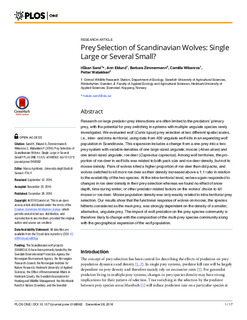Prey Selection of Scandinavian Wolves: Single Large or Several Small?
Journal article, Peer reviewed

Åpne
Permanent lenke
http://hdl.handle.net/11250/2427377Utgivelsesdato
2016Metadata
Vis full innførselSamlinger
Sammendrag
Research on large predator-prey interactions are often limited to the predators' primary
prey, with the potential for prey switching in systems with multiple ungulate species rarely
investigated. We evaluated wolf (Canis lupus) prey selection at two different spatial scales,
i.e., inter- and intra-territorial, using data from 409 ungulate wolf-kills in an expanding wolf
population in Scandinavia. This expansion includes a change from a one-prey into a twoprey
system with variable densities of one large-sized ungulate; moose (Alces alces) and
one small-sized ungulate; roe deer (Capreolus capreolus). Among wolf territories, the proportion
of roe deer in wolf kills was related to both pack size and roe deer density, but not to
moose density. Pairs of wolves killed a higher proportion of roe deer than did packs, and
wolves switched to kill more roe deer as their density increased above a 1:1 ratio in relation
to the availability of the two species. At the intra-territorial level, wolves again responded to
changes in roe deer density in their prey selection whereas we found no effect of snow
depth, time during winter, or other predator-related factors on the wolves' choice to kill
moose or roe deer. Moose population density was only weakly related to intra-territorial prey
selection. Our results show that the functional response of wolves on moose, the species
hitherto considered as the main prey, was strongly dependent on the density of a smaller,
alternative, ungulate prey. The impact of wolf predation on the prey species community is
therefore likely to change with the composition of the multi-prey species community along
with the geographical expansion of the wolf population.